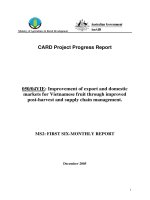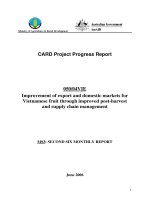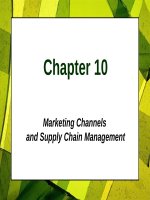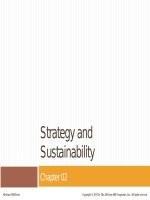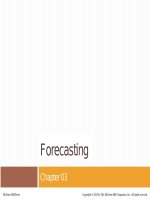Lecture Principle of inventory and material management - Lecture 15
Bạn đang xem bản rút gọn của tài liệu. Xem và tải ngay bản đầy đủ của tài liệu tại đây (739.78 KB, 40 trang )
Lecture 15
Purchasing and Supply Chain
Books
•
Introduction to Materials Management, Sixth Edition, J. R. Tony Arnold, P.E., CFPIM, CIRM, Fleming
College, Emeritus, Stephen N. Chapman, Ph.D., CFPIM, North Carolina State University, Lloyd M.
Clive, P.E., CFPIM, Fleming College
•
Operations Management for Competitive Advantage, 11th Edition, by Chase, Jacobs, and Aquilano, 2005,
N.Y.: McGrawHill/Irwin.
•
Operations Management, 11/E, Jay Heizer, Texas Lutheran University, Barry Render, Graduate School of
Business, Rollins College, Prentice Hall
Objectives
•
•
•
•
•
•
•
•
•
Purchasing overview
Purchasing cycle
Purchasing function
Make or buy decision
Purchasing techniques
JIT purchasing
Supply chain management
Outsourcing
Ethics in Supply chain
Purchasing Overview
•
•
Purchasing
– The acquisition of goods and services.
Purchasing Activity
– Helps identify the products and services that can be
best obtained externally; and
– Develops, evaluates, and determines the best
supplier, price, and delivery for those products and
services.
Purchasing Objectives
•
•
•
•
Obtaining goods and services of the required quality
and quantity.
Obtaining goods and services at the lowest cost.
Ensuring the best possible service and prompt delivery
by the supplier.
Developing and maintaining good supplier relations
and developing potential suppliers.
Purchasing Functions
•
•
•
•
Determining purchasing specifications: quality,
quantity, delivery
Selecting suppliers
Negotiating terms and conditions of purchase
Issuing and administering purchase orders
Purchasing Cycle
•
•
•
•
•
•
•
Receiving and analyzing purchase req’s.
Selecting suppliers
Determining the right price
Issuing purchase orders
Following up to assure delivery dates are met
Receiving and accepting goods
Approving supplier’s invoice for payment
The Typical Procurement Cycle
Order Cycle
(one to three weeks)
Order Request
Verification by inventory
control
Purchasing researches
suppliers, obtains quotes, etc.
Signatures obtained
Order mailed
Receiving Cycle
(one week)
Receiving
Incoming inspection
Inventory control receives
order, updates records,
and notifies department
Supplier Cycle
(one to many weeks)
Supplier receives and
enters order
Supplier manufactures
or “picks” order
Supplier ships order
Purchasing Terminology
•
Purchasing Agent
–
•
Has legal authority to execute contracts on behalf of the
firm.
Make or Buy Decision
–
–
–
Choosing products and services that can be
advantageously obtained externally or produced
internally depending on which is best for the company.
Vertical Integration
Developing the ability to produce goods or services
previously purchased, or actually buying a supplier or a
distributor.
MakeorBuy Decisions
Reasons for Making
Maintain core competence
2. Lower production cost
3. Unsuitable suppliers
4. Assure adequate supply (quantity or delivery)
5. Utilize surplus labor or facilities
6. Obtain desired quality
7. Remove supplier collusion
8. Obtain unique item that would entail a prohibitive
commitment for a supplier
9. Protect personnel from a layoff
10. Protect proprietary design or quality
11. Increase or maintain size of company
1.
MakeorBuy Decisions
Reasons for Buying
Frees management to deal with its core competence
2. Lower acquisition cost
3. Preserve supplier commitment
4. Obtain technical or management ability
5. Inadequate capacity
6. Reduce inventory costs
7. Ensure alternative sources
8. Inadequate managerial or technical resources
9. Reciprocity
10. Item is protected by a patent or trade secret
1.
Make/Buy Considerations
Reasons for Making
•
•
•
•
•
•
•
Reasons for Buying
Lower production cost
Unsuitable suppliers
Assure adequate supply
Utilize surplus labor and make
a marginal contribution
Obtain desired quantity
Remove supplier collusion
Obtain a unique item that
would entail a prohibitive
commitment from the supplier
•
•
•
•
•
•
Lower acquisition cost
Preserve supplier commitment
Inadequate capacity
Reduce inventory costs
Ensure flexibility and alternate
source of supply
Product improvements may be
difficulty because it is a
sideline
Purchasing Terminology
•
Keiretsu
–
The Japanese word to describe a company coalition
with longterm contracts with the firm; members of
the Keiretsu function much like partners would.
Supplier Relations
•
Three aspects of supplier relations
–
Supplier Evaluation Involves finding potential
suppliers and determining the likelihood of their
becoming good partners.
– Supplier Development May include everything from
training, to engineering and production help, to formats
for electronic transfer.
– Negotiations Are of three classic types: costbased
model, marketbased price model, and competitive
bidding.
Sourcing
•
•
•
Sole sourcing implies that only one supplier is
available.
Multiple sourcing is the use of more than one
supplier for an item.
Single sourcing is the selection of one item for an
item when several sources are available.
Factors in Selecting Suppliers
•
•
•
•
•
•
•
Technical ability
Manufacturing capability
Reliability
Aftersales service
Supplier location
Price
Other considerations
Supplier Relations
•
•
•
•
•
The supplier should be treated as an extension of the
company.
Longterm, close relationships with a few suppliers is best
for many critical products.
The supplier should be committed to helping the purchaser
improve its product and win orders.
Suppliers can also be a source of ideas about new
technology, materials, and processes.
A good supplier relationship is like a marriage.
Supplier Relations
The following characteristics have been
proven to be present in good relationships.
•
•
•
•
•
•
Commitment
Communication
Working through change / improvement
Principles centered relationship
Spending time together
Appreciation / recognition / feedback
Supplier Relations
•
Negotiation Strategies
–
–
–
CostBased Model Requires the supplier to open
its books so that the purchaser can determine actual
costs.
MarketBased Price Model Based on a published
price or index such as exists for many metal and
paper suppliers.
Competitive Bidding Appropriate where suppliers
are not willing to discuss cost or where near perfect
markets do not exist.
Negotiations and Product Type
•
•
•
•
Commodities: Contracts for future prices.
Standard Products: May negotiate large
purchases.
Items of Small Value: Minimize cost of
ordering. Negotiate ordering system.
Madetoorder items: Can be negotiated.
Purchasing Techniques
•
•
•
•
•
•
Blanket orders
Invoiceless purchasing
Electronic ordering and funds
transfer
Electronic data interchange (EDI)
Stockless purchasing
Standardization
Purchasing Techniques
•
Blanket Orders
–
•
A contract to purchase certain items from a vendor,
although they all may not be delivered until
requested by the purchaser.
Invoiceless Purchasing
–
Appropriate where substantial trust exists between
the purchaser and supplier and deliveries are made on
a regular basis and are easily verifiable.
Purchasing Techniques
•
Electronic Ordering and Fund Transfer
–
•
Stockless Purchasing
–
•
Reduces cost by reducing paperwork; also increases the
speed of ordering.
Developing with the supplier, a means of reducing
inventory costs by the supplier holding inventory.
Standardization
–
A technique for reducing purchases for specialized
items when in fact a very similar standard product is
commercially available.
Supplier Concerns in JustinTime Purchasing
•
Desire for Diversification.
–
•
Poor Customer Scheduling.
–
•
Supplier is concerned about all business stemming from
single customer.
Supplier is concerned that customer will not be able to
develop smooth, consistent schedule.
Engineering Changes.
–
Supplier is concerned that customer will promulgate
frequent engineering changes with inadequate lead time.
Supplier Concerns in JustinTime Purchasing
•
Quality Assurance.
–
•
Small Lot Sizes.
–
•
Supplier may consider production with zero defects
unrealistic.
Many suppliers are unaccustomed to working with small
lot sizes.
Proximity.
–
Delivery of small lot sizes over long distances may not
be economical.
The Supply Chain’s Strategic Importance
Supply chain management is the
integration of the activities that procure
materials and services, transform them
into intermediate goods and the final
product, and deliver them to customers
Competition is no longer between
companies; it is between supply chains

